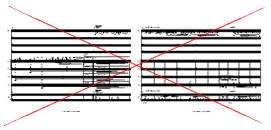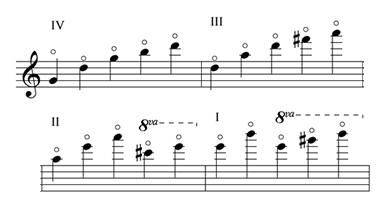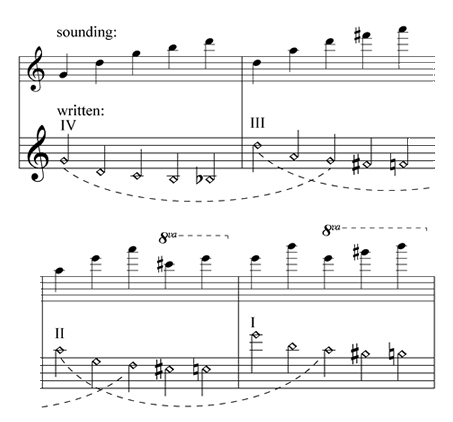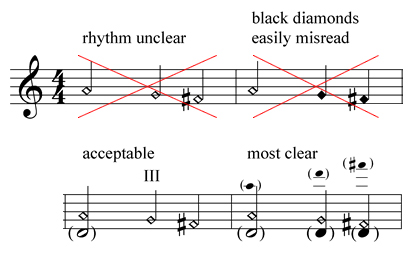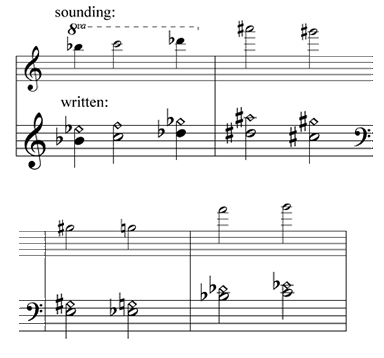Music Notation Style Guide
The faculty of the IU Composition Department recognizes that there is not uniform field-wide agreement about many notational issues composers face. This style guide is being developed in an effort to standardize at least the IU composition department preferences for notation, particularly regarding theses and dissertations. Principal authors are David Dzubay and Don Freund, writing in consultation with Claude Baker, PQ Phan and Aaron Travers. © David Dzubay & Don Freund.
The overriding goal of this guide is clarity of musical intent and professionalism. Rules are made to be broken, if for good reason. However, if you are preparing a thesis or dissertation, consult with your document chair before deviating from the guide below; this will save everyone a great deal of time.
Standards of Notation
The composition department recognizes the three works listed below as standards of notational practice; you should refer to one of them when in doubt about correct procedures, and should consult your committee for advice.
Gould, Elaine. Behind Bars. London: Faber Music Ltd, 2011.
Read, Gardner. Music Notation: A Manual of Modern Practice. Second Edition. Boston: Crescendo Publishers, 1969. (paperback edition: New York: Taplinger Publishing Company, 1979)
Stone, Kurt. Music Notation in the Twentieth Century: A Practical Guidebook. New York: W. W. Norton, 1980. (Based on the International Conference on New Music Notation in 1974.)
Rev. 10/09, 4/10, 8/11
ACCIDENTALS
Use accidentals for new octaves of same pitch class.
Use a courtesy accidental for a natural pitch in a new bar, following the same pitch name in the previous bar with an accidental.
ARTICULATIONS
Articulations should be placed on the note head side, and with the exception of the staccato mark should be placed outside the staff.
BARLINES
a) Use double barlines to indicate sudden changes of tempo - both isolated changes and strict tempo modulations (quarter = dotted quarter).
b) In some situations, it can be helpful to use (single) heavy barlines to indicate phrase divisions, or groupings of bars. An example would be in a fast piece conducted in one; a thick barline here and there relating to the musical phrasing will help players not get lost.
c) do NOT follow the old practice of using double barlines at changes of meter.
d) barlines should break between choirs according to the large group bracketing.
BEAMING
Beaming Reinforces Meter. A common error is beaming to show phrasing instead of meter. Articulations alone can serve this purpose. Cross-bar beaming is not uncommon in solo music, but adds unnecessary difficulties to large ensemble writing.

Feathered Beaming shows a gradual change in the speed of notes. Shown with a straight primary beam and one or two diagonal secondary beams (respectively implying an approximation of sixteenth notes or thirty-seconds at the fastest moment), the fanning out of beams shows acceleration and contraction shows deceleration. Though this has become a relatively common notational device, it will not be familiar to all players; adding a note of explanation is recommended at the first usage and in the performance notes. When an indeterminate number of articulations is desired, usually on the same pitch, the effect of rushing or pulling back is more important than counting the notes. The recommended notation for this is using a normal notehead for the first pitch, followed by a series of headless stems, as shown below. When feathered beaming implies an indeterminate number of pitches, the duration of the figure may be unclear. By bracketing a note value (such as dotted half note) over the music, this question will be eliminated. Finally, stem placement should reflect the acceleration or deceleration.
BRACKETS
For orchestra: bracket each choir (woodwinds, brass, percussion [not timpani, piano, harp], strings); secondary brackets on like instruments (flutes, trumpets, violins, etc.); third level brackets for violin divisi.
BRASS
Muting
For trumpet and trombone, specific mute indications should be used: st. mute, harmon mute, cup mute, etc.
Muting should be cancelled with "open." (Leave "senza sord." for the strings, unless you are going to translate 'straight,' 'harmon,' and 'cup' into Italian as well - inadvisable.)
Harmon mute: at first occurrence, indicate either a) stem in, b) stem extended, or c) stem removed.Mute reminders should be placed on all left side score pages, Generally use abbeviations placed either just below abbreviated staff name, or above the staff, using parentheses. See STAFF NAMES.
Slurs = legato groups of notes played without rearticulating with the tongue. If you feel you must indicate phrasing, use dotted slurs.
Multiple instruments per staff for brass is allowed, provided the music is very easy to read. Passages that are at all complex should be divided into separate staves for each instrument.
CUES (for parts)
Generally, include a cue if an instrument is resting for more than 10 bars. Beyond true 'cues' that insert other instruments' music, one can also include 'cues' that help a player through a long rest by indicating prominent changes of texture: "brass", or "flute solo", at the start of multi-measure rests, for example.
FONT STYLES and SIZE
Size
Tempos: large enough to be easily read by a conductor from 3 feet away from score. (Generally, 18-24 point works well, depending on the page reduction level)
Capitalization
Principal tempo indications are capitalized: Adagio, Moderato, Allegro, Tempo I, Fast, Slow,...
Tempo qualifications and changes are not capitalized: a poco a poco, assai, molto, meno, little by little, accelerando, a tempo, ritardando, più mosso, rubato, stringendo,slowing, quickening,...
Italics
Less common foreign language terms should be italicized, but many words commonly used in music scores need not be italicized, including: pizz., arco, div., unis., a tempo, etc.
from Wikipedia:
Generic titles are those that are not specific to one musical work, e.g., the names of musical forms such as concerto, overture, quartet, sonata, suite, symphony. Titles of liturgical works, such as Agnus Dei, Kyrie, Mass, Requiem, etc. – are considered generic titles, as well. Generic titles are in roman face.
- Piano Concerto No. 5
- Sixth Symphony
- Requiem
True titles are titles specific to a single work. These are titles given by the composer much as an author would title a novel. True titles are italicized, irrespective of which language they are in.
- From me flows what you call time
- Pelléas et Mélisande
From the IU Style Guide:
Foreign words and phrasesCommonly used foreign expressions and their abbreviations are not italicized:
e.g., i.e., ex officio, et al., vis-à-vis, cum laude, in vivo, in vitroLess common foreign terms are italicized: dies irae (day of wrath)
If a term you’re unsure of is listed in the Webster’s “Foreign Words and Phrases” section, it should be italicized. If it’s in the regular listing, don’t italicize it.
MARGINS (Thesis, Dissertation)
Electronically submitted documents must use 1" margins on all four sides. If submitting a bound hard copy of a document, 1.5” inner margins must be used to allow for binding. The non-binding edges all should have 1" margins. The margin is interpreted to be the area within which nothing should be printed, i.e., the distance from the edge of the paper to the first dot of ink (with the exception of page numbers).
WARNING: Do not make your margins overly large, leading to extra page turns and less music per page than is ideal.
HELPFUL HINT: Make your staff name abbreviations concise and tight.
MEASURE NUMBERS
Use measure numbers well, preferably in the following four ways:
a) At the start of every system (not enclosed, unless the measure number also serves as a rehearsal landmark)
b) At structural points and/or rehearsal landmarks. Rather than letters (which is also acceptable), using the actual measure number, preferably in a larger font and/or in an enclosure, is the best way to indicate rehearsal landmarks. Just one counting system to deal with, and rehearsal spots are quickly found. NOTE: ALL PLAYERS should have these numbers, so make sure to break multi measure rests at these points.
Additionally, for parts:
c) At barlines following all multi-measure rests.
d) Sprinkled liberally throughout the part, especially toward the right side of systems, where it might take some time counting to find certain bars in rehearsal. After a part is edited and formatted, go through it once, adding measure numbers where appropriate.
WARNING: Never use the system of placing measure numbers every 5 or 10 bars. This breaks up multi-measure rests into un-musical divisions.
ALSO: It is acceptable in large ensemble scores to place a measure number below every measure (not in the parts, though).
METER
Metric considerations. There are three categories of meters:
- Simple meters. Beats naturally divide into two divisions (e.g., 4/4).
- Compound meters. Dotted note beats naturally divide into three divisions (e.g., 6/8).
- Complex meters. Beats divide unevenly, into a combination of two, three (or four) units (e.g., 5/8) or asymmetrically (e.g., 2/4+3/16)
Some meters are more comfortable for most players than others. Remember the following rule: rhythms will be performed more accurately and confidently in familiar time signatures. When orchestrating a piece that uses unfamiliar meters, consider converting to more common ones. Contemporary musicians are most familiar with simple meters that have quarter note beats (3/4, 4/4, etc.) and compound meters with dotted quarter note beats (6/8, 9/8, etc.). Though complex meters in Western music are less familiar than simple or compound ones, they are often necessary, and are most easily read when the denominator is 8 (5/8, 7/8, 11/8, etc.) If the option exists, make reading music as easy as possible—use familiar time signatures.
Dividing Complex Meters. Since the beat value of complex meters is not consistent, the division of all measures must be immediately evident to the conductor and all players. If not, rehearsal time will undoubtedly be wasted as this information is communicated verbally to the ensemble. There are several ways to clearly delineate this information:
- Performance Note. If the complex meter is always divided in the same way, make some kind of note about this (e.g., all 5/8 measure are divided 2+3).
- Rhythmic Notation. The rhythmic notation should always reinforce the metric divisions. Some correctly notated rhythms are inherently ambiguous, and must be combined with numeric delineation
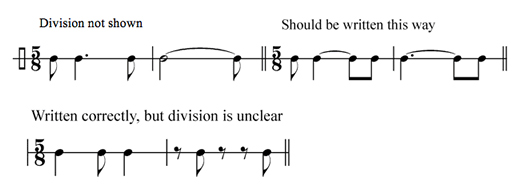
- Numeric Delineations. If a 7/8 measure, divided 3+2+2, is followed by a 2+3+2 construction, simply write the divisions on the manuscript.
- Rest Delineations. Though whole rests normally fill full measures of rest in any meter, empty bars in complex meters may print rests to show the beat divisions.
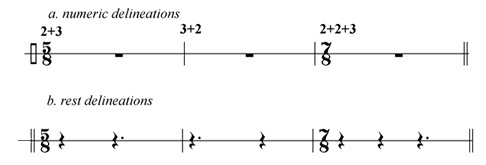
Changing Meters/Metric Modulation. When switching between meter types (simple, compound, and/or complex), the relationship between beats must be clear. Markings such as ![]() show that the eighth note stays constant. Tempo modulation (or Metric modulation), shown by markings like
show that the eighth note stays constant. Tempo modulation (or Metric modulation), shown by markings like ![]() indicate that the beat stays the same, but its division changes. A thin double barline should always accompany a metric modulation. The parenthetical tempo markings below are included to reinforce the tempo relationships.
indicate that the beat stays the same, but its division changes. A thin double barline should always accompany a metric modulation. The parenthetical tempo markings below are included to reinforce the tempo relationships.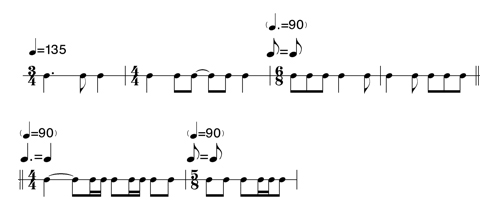
Meters With Too Many or Too Few Beats. Use Meters of 2, 3, 4 beats for the most part. Sometimes 5 or 6. Avoid large meters of 7, 8, 9, or more beats in a bar. These are usually broken down into twos and threes anyway, and the downbeat is easily confused. Players sometimes get lost when following a conductor through measures with seven or more beats. Consider dividing the measure with a dotted barline or splitting these into two separate bars. This technique may be helpful for five-beat bars as well. One-beat measures can be problematic as well; grouping two bars together may be easier to read. If you can't resist your inner Beethoven and are writing music "in 1", consider using thicker bar lines to mark phrase divisions - this helps avoid players getting lost.
MUSIC SIZE [Especially for thesis/dissertation***]
Scores to be conducted MUST be sized so that the music can be read from 3 feet away.
It should be expected that for orchestra and other large ensembles, system to system vertical spacing adjustment will be necessary to avoid collisions. It is NOT acceptable to size the music extremely small, with large spans between staves simply to avoid all collisions in one fell swoop.
On the other hand, do not size the music too large; this leads to scores with many unnecessary page turns and makes phrasing and musical flow hard to follow.
***Consult with your committee EARLY in score preparation to make sure that your formatting approach is acceptable.
ORIENTATION
Format all scores and parts in PORTRAIT Orientation. This is the professional publishing standard. Sometimes composers use landscape because they think it fits the ensemble size better; in such cases, composers should simply format for two or more systems on each page. Landscape scores fall off stands, necessitate unwieldy, even theatrical page turns, often require two stands, and simply look unprofessional. Remember that once a portrait-oriented score is opened, it is wider than it is tall, so opening a landscape score makes for a doubly wide document.
NOTE: Composing on landscape manuscript paper (11x17) is a different matter and highly recommended - just don't 'engrave' your final scores in that format!
OPTIMIZATION
Score optimization should be used only in certain circumstances, like when doing so will allow two or more systems on one page. You should NOT optimize every page as a matter of course, as this can create too many irregularities from page to page, making scores difficult to read.
PARTS
a) Print parts on 10 x 13 paper.
No, this is not a stock size, but you can easily order it or cut it down from 11x17 yourself. 10x13 is the best size for parts, and is the required size for some professional ensembles, including the Minnesota Orchestra. Here are some ways to print on 10x13. First, format and edit your music in Finale or Sibelius knowing you will end up printing on 10x13, so size the music accordingly. Second, If you have access to a printer that can accept 13x20 paper, order your paper of choice from a supplier like Xpedex, having them cut it to 13x20 for you. The paper type should be "offset", 60# or 70#, "text," preferably a light natural color, not too dark and not white. One paper I like is Cougar Natural 70# Text Offset. If your printer won't take 13x20, order the paper cut to 10x13 and use this in either your printer or a photocopier. In a pinch, just cut down some white 11x17 stock yourself.
Best: Print two pages per side on 13x20 paper, fold and staple in center (or cut and bind for larger documents). 4 page document: print 4&1 / 2&3. 8 page document: print 8&1 / 2&7, 6&3 / 4&5. 12 pages: 12&1 / 2&11, 10&3 / 4&9, 8&5 / 6&7 etc. Or, print one side per page onto 10x13
Good: print originals on letter size paper, and photocopy at 117% onto 10x13 paper (fed through "bypass" feeder). Or, print originals on tabloid (using just 11x14 of the paper), and photocopy at 92% onto 10x13 paper.
Note: 11x14 is second best (though it doesn't fit well in folders), 8.5x11 is third best (make sure the music is not too small).
Exception: For short pieces or pieces you'll be photocopying large runs of (perhaps for band, for example), it can work well to format for letter size, print "2 up" onto tabloid (print pages 4&1, then 2&3 on the back side), fold, and staple if the part is more than 4 pages (requiring more than one sheet of 11x17).
b) Bind all scores and parts properly. If you can print on 13x20, fold and staple. Absolutely never hand out loose sheets that can easily fall off stands, or get out of order.
Best for parts and thin scores (if large paper, like 13x20 is available): folded and stapled in center. Get a large stapler to make this easy.
Best for thick scores: Coil. Note - buy coils that are long enough. Do not use 11" coils on 17" scores. [PED has a CoilMac machine available for use by IU composition majors. Bring your own coils.]
Good: Tape. Works for parts, rarely for scores. Use a flexible tape, like medical tape or duct tape (!). You can buy a "tape binder," but they are expensive. You can also learn to stack the pages, sort of bend them back and forth to fan the pages out, lay down on flat surface, and tape. The fanning out makes the tape reach each page. Also, this should be done so that the next page that needs to be turned is sticking out a bit.
Worst: Comb. Can work in a pinch, but is not allowed by groups like the Minnesota Orchestra. Noisy...easily damaged...doesn't fit in folders well. If you must use comb, don't use 11" combs for 17" scores and don't overlap combs. Order combs that are long enough.
Even worse: Stapled on the side. Documents don't lay open flat.
c) Plan page turns carefully, on odd-numbered pages, starting with 1. While in RARE cases it might make sense to start a part on the left side page, with the first page turn on 2, this should be avoided in preference for the professional publishing standard of a right hand page start. There is no reason to begin a score with a left page.
1) Page Turns are more important than saving paper. Plan page turns where there is plenty of time, even if it means having just a couple of systems on a page.
2) Instrumentalists should not have to play immediately following a page turn. In other words, try to have bars of rest either side of a turn. (No surprises!)
3) Place a warning (V.S.) when a quick page turn is necessary.
4) A finished part does not require a player to photocopy because page turns were not accounted for. Solve the problem before you hand the part out, either with formatting, or if absolutely necessary, a fold-out.
d) Use Measure Numbers well.
PERCUSSION
Reminders should be placed on all left side score pages, so conductors don't need to flip back through the score to figure out what instruments are being played. Generally use abbeviations placed either just below abbreviated staff name, or above the staff (using parentheses in that case). SeeSTAFF NAMES.
A list of all percussion instruments used in the work should be included in the score on the instrumentation page and at the start of the percussion part. If appropriate, a set-up diagram should be included. However, do not rely on players and conductors memorizing this - be sure to indicate changes of instruments where they occur in the music.
Percussion Notation: (It is best to define the notation in score & part at the first instance.)
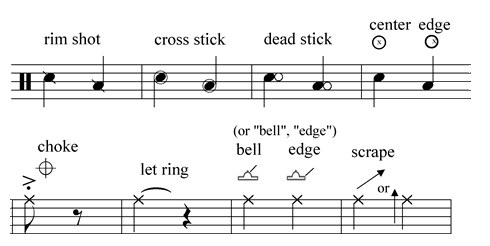
Drum Set Notation:
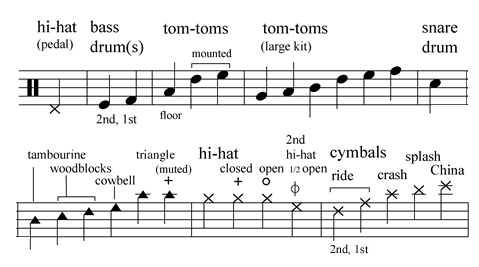
Orchestral percussion will often use different assignment strategies. It is usually best to keep skins on spaces and woods or metals on lines, for example. Use of alternate noteheads for metals is suggested. Generally arrange each family (skins, metals, woods) from low to high on the staff. A few examples:
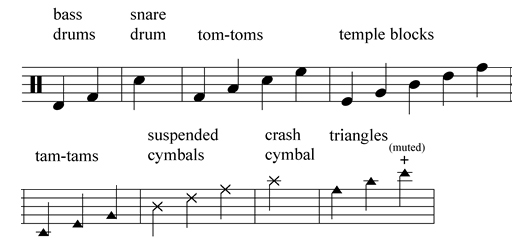
Alternate staves with fewer lines are acceptable, especially if that part only uses one or two instruments. When writing a part with multiple instruments and fast changes (or simultaneous use of different instruments) it is best to use a regular five line staff to avoid frequent staff changes.
PLACEMENT OF TEMPO MARKINGS, MEASURE NUMBERS & REHEARSAL LANDMARKS
For orchestra: at minimum, at top of score and above string section; possibly above brass and above percussion as well, depending on size of the orchestra. For band: top of score, above brass, above percussion.
REHEARSAL NUMBERS/LETTERS (see Measure Numbers)
Rehearsal landmarks, using measure numbers or letters, should be included at frequent intervals, usually about every 10 bars.
RHYTHM
While there are often multiple ways to beam and group given rhythms, some solutions are easier to read than others. Incorrect rhythmic notation greatly increases the risk of misplayed rhythms, and is one of the “deadliest” errors made by young orchestrators.
Show Me The Beats! It is useful to think of “levels” of metrical hierarchy when notating rhythm. For example, in 4/4 time, events that happen on the half-note level (beats 1 or 3) are one metrical level higher than events on the quarter-note level (beats 2 and 4). One level lower is the eighth-note (events which occur on the “and” of the beat), further divided into the 16th-note level (events which occur on the 2nd or 4th sixteenth note of a quarter-note beat). If a note begins or ends on a level two degrees lower than a beat through which it sustains, the note should be divided, with a tie used to show the higher level beat. Observe the examples below.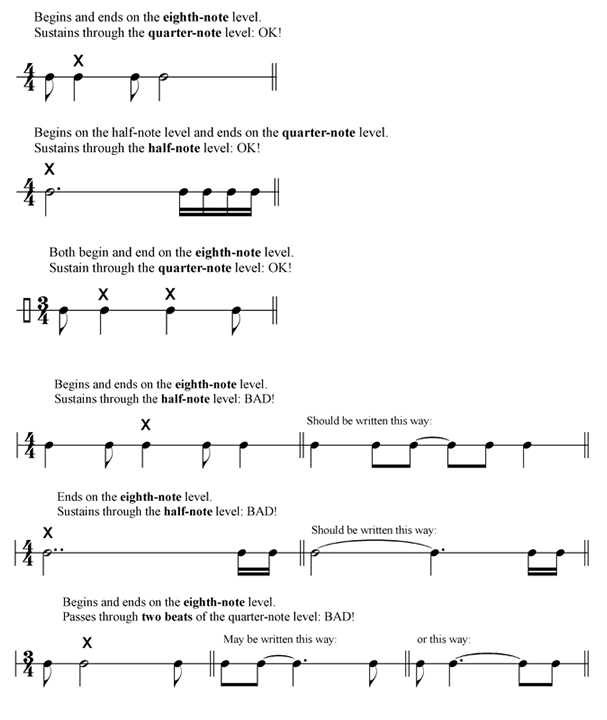
Rests Reinforce Meter. Rests notation follows the same stipulations as notes with a few additional considerations. In a three beat measure, avoid the use of a rest equaling two beats in duration (ex. avoid half rests in 3/4). In measures with four beats, beat 3 must usually be shown, so use a half rest to cover beats 1 and 2 or 3 and 4, but two quarter note rests for beats 2 and 3. Whole rests are used to cover a full measure in ANY meter (with the single exception of rest delineations in complex meters, as described above.) 
Augmentation Dots. Dotted rests at the beat level or higher should be reserved for compound meters. For example, dotted quarter rests should not appear in a measure of 2/4. Rests at the division or subdivision level may be dotted (i.e. dotted eighth rests in 2/4 are actually clearer than writing an eighth rest followed by a sixteenth rest). Dotted notes are fine, as long as they emphasize the meter, and don’t break any of the rules above. Double dotted notes and rests are confusing, often misplayed, and should be avoided.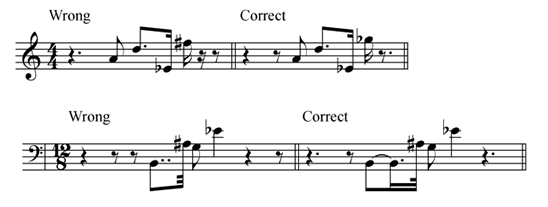
Thirty-Second Notes. If a piece requires frequent thirty-second notes, consider doubling the note values (ex. thirty-second notes in 4/8 become sixteenths in 4/4). In the example below, the first measure shows a written rhythm, the second bar includes a common misinterpretation, and the final measure demonstrates a foolproof alternative notation.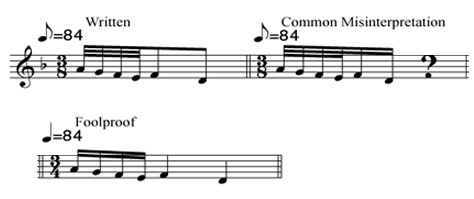
SIMILE
Avoid using "simile" -- this weakens the visual character of your score and creates ambiguity regarding how long the "simile" is in effect. Articulations, dynamics, slurring and hairpins are easily copied independent from pitches. Redundant markings are not distractions, but welcome reinforcements.
STAFF NAMES
Finale "staff styles" (or the Sibelius equivalent) should be used as extensively as possible to indicate the prevailing instrumentation as the instruments are listed in the left margin of every score page. These are absolutely necessary for instrument doublings (eg., Fl/Picc., Piano/Celesta). These may also be used to indicate the prevailing mute situation, extended pizzicato passages, and percussion instrumentation.
Suggested abbreviations: Picc., Fl., Ob., E.Hn., Cl., Bcl., Bn., Hn., Tp., Trb., Btrb., Tba., Timp., Pc., Hp., Pn., Vn., Va., Vc., Cb.
STRINGS
Divisi
div. = section divided; unis. cancels the divisi.
tutti follows indications for partial section playing, like solo, soli, or la metà.non divisi and/or brackets should be use to indicate undivided multiple stops.
The divisi situation should always be indicated with div., div. a3, etc. near abbreviated staff names or group names. See STAFF NAMES.
Divisi sections that are at all complex should be divided into separate staves for each line. Block chord long tones can remain on one staff; divisi in rhythmic counterpoint or with fast moving lines should be separated in both score and part.
Harmonics
a) A small circle above a note indicates that the note should be played as a natural harmonic sounding at the given pitch. Natural harmonics are quite resonant, bright and pure sounding. Some composers (Harrison Birtwistle, for instance) simply write all natural harmonics (or even all harmonics, period!) this way, leaving it for the player to choose the most convenient way to produce the written pitch; this relies on very experienced players. Generally, this approach would be advisable only for long tones or slow passages, with plenty of time to think about how to produce the pitch. Natural harmonics up through the sixth partial are easily available. For example, on violin we can write and hear:
b) A diamond indicates a 'touch', showing a player where to lightly touch the string without pressing down to the fingerboard. It is usually assumed that a diamond alone shows a touch on the open string next found below the touched pitch. If there is any ambiguity, like with G4 on violin, the intended string should be indicated with, for example, "sul D" or "III" or a notehead in parentheses on the open string. A diamond is usually not showing the sounding pitch, though this is the case at the first harmonic, one octave above open string, for example. When using diamonds to indicate natural harmonics, it is often a good idea to show the sounding pitch as a disconnected notehead in parentheses.
The dotted slurs connect diamonds that can be ambiguous as to which string they should be played on. For such diamonds, be sure to indicate the string. Note that the diamonds above show the most common nodes that are touched and written for - there are other nodes (locations) on the string where the same resulting harmonics can be found.
c) Make sure the duration is clear when writing natural harmonics. A diamond notehead with stem might be a quarter or a half. Do not use solid/black diamonds - they are easily mistaken for regular note heads. Instead, show the duration with a notehead in parentheses on the open string. The fourth example is best, especially when writing a fast moving passage, or when writing for less experienced players. An alternative to writing the sounding pitches in parentheses would be a second staff above, showing sounding pitches.
d) Most artificial harmonics should be "touch perfect fourths," stopping a string on a pitch and touching a perfect fourth higher, producing a harmonic two octaves higher than the stopped pitch - players are most familiar with this particular artifical harmonic. Artificial harmonics have a slightly different sound than natural harmonics - more covered, smooth, even expressive. Intonation is more flexible with artifical harmonics, and all chromatic pitches are available (starting two octaves above lowest string). Touch perfect 5th harmonics (sounding an octave and a P5 above stopped pitch) are possible, especially on violin, though in the lowest register they may not be easily reached. M3 and m3 harmonics are also used, especially for contrabass. M3 touch sounds 2 octaves and a M3 above stopped pitch; m3 sounds two octaves and a P5 above stopped pitch.
e. Ties. For artificial harmonics, both notes (stopped pitch and diamond) use ties and augmentation dots.
Slurs = bowings. If you feel you must indicate phrasing, use dotted slurs.
TEMPO INDICATION / METRONOME MARKINGS
a) Use metronome speeds for tempo indications (not simply "Allegro"). These should be either clear directions for a new tempo (no parentheses) or reminders/clarifications of a tempo (with parentheses, as when associated with a "Tempo I" indication).
b) Horizontal placement: The left edge of the tempo indication should align with the left edge of the meter, or the first notational element.
c) Use only one number, not a range, unless the tempo is supposed to be in flux, speeding up and slowing down within a range.
![]()
NOTE: Neither a or c overly restrict players, who, as human beings, will approximate tempo, and vary as necessary depending on the situation (acoustics, etc.). Giving precise tempo indications is particularly important in works with a variety of tempi, as the relationship between different tempi is then clear. Musicians will appreciate the clarity of intent.
d) Use numbers found on analog metronomes:40, 42, 44, 46, 48, 50, 52, 54, 56, 58, 60, 63, 66, 69, 72, 76, 80, 84, 88, 92, 96, 100, 104, 108, 112, 116, 120, 126, 132, 138, 144, 152, 160, 168, 176, 184, 192, 200, 208; musicians are familiar with these tempi. Avoid speeds like 113, unless a precise tempo modulation gets you to that somehow.
e) Express tempo and meter in terms of the duration that will be conducted or felt as the pulse.

Exception: when the meter doesn't clearly express the pulse (5/8, 6/8, 7/8, etc. conducted or pulsed in quarters and dotted quarters.)
TUPLETS
The recently coined term “tuplets” refers to irregular subdivisions of metrical units; triplets and sextuplets are the most familiar. Always grouped by either a beam or a bracket, the amount of notes per unit must be shown with a number. There has been some debate about the “correct” way to notate tuplets. Some feel that they speed up a note value, while others argue they slow it down. For example, beat-long quintuplets in 12/8 have been notated as five quickened eighth notes or five slowed down sixteenths; more recently, as in the music of Elliott Carter or Oliver Knussen, this quintuplet is written as five dotted sixteenths, which is the most accurate representation. If the beat unit being divided is in any way ambiguous, it is recommended that a ratio (5:3) or an equation (5 = [dotted quarter]) be given.
Duplets and quadruplets can cause confusion as well, especially in large ensemble situations, and there are many good reasons why they should be forever replaced by actual non-tuplet dotted notes; a dotted half divides perfectly into two dotted quarters and four dotted eighths, with no tuplets required.
All tuplets should be easily read. There is not complete agreement on a rule to handle all tuplets, but in general:
- use square brackets if a bracket is needed, as when the tuplet begins or ends with a rest. [Do not use slurs for tuplets.]
- place the tuplet number outside staff.
- do not allow a tuplet to separate a note head and its articulation.
- avoid cluttering up the note head side (articulation must be on note head side; adding slurs and tuplets there can create problems).
Possible 'systems' to follow, advocated variously at IU (consult your chair for preferences):
1. tuplets always on stem (or beam) side.
2. tuplets always above.
3. varied, according to the situation, choice made for maximal clarity.
In any case, the notation should be clear and consistent, and have no collisions.
WOODWINDS
Slurs = legato groups of notes played without rearticulating with the tongue. If you feel you must indicate phrasing, use dotted slurs.
Multiple instruments per staff for winds is allowed, provided the music is very easy to read. Passages that are at all complex should be divided into separate staves for each instrument.
BIBLIOGRAPHY
Beck, John. Encyclopedia of Percussion. New York: Garland Pub., 1995.
Brindle, Reginald Smith. Contemporary Percussion. New York: Oxford University Press, 1991.
Gould, Elaine. Behind Bars. London: Faber Music Ltd, 2011.
Read, Gardner. Music Notation: A Manual of Modern Practice. Second Edition. Boston : Crescendo Publishers, 1969. (paperback edition: New York : Taplinger Publishing Company, 1979)
Stone, Kurt. Music Notation in the Twentieth Century: A Practical Guidebook. New York : W. W. Norton, 1980. (Based on the International Conference on New Music Notation in 1974.)
Weinberg, Norman. Guide to Standardized Drumset Notation. Lawton: Percussive Arts Society, 1998.


